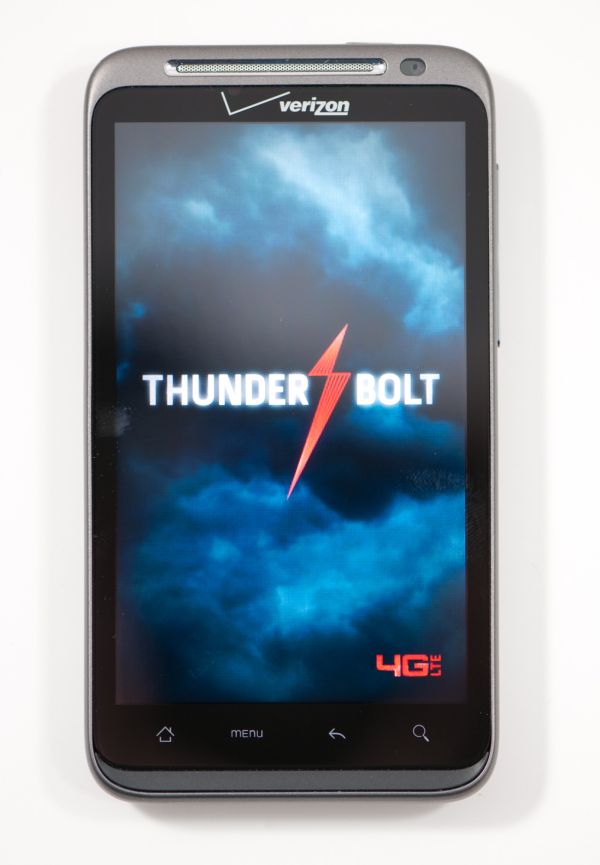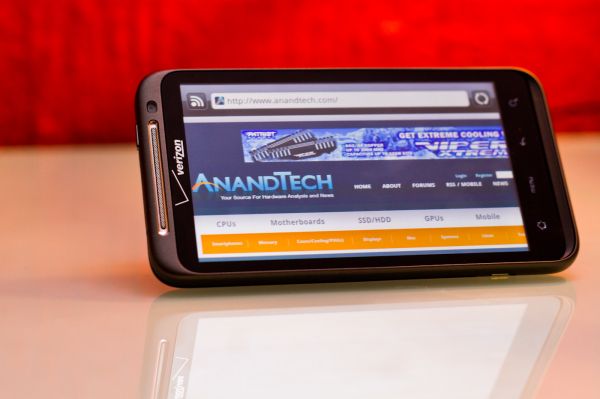HTC Thunderbolt Review: The First Verizon 4G LTE Smartphone
by Brian Klug on April 27, 2011 12:12 AM EST- Posted in
- Smartphones
- HTC
- Verizon
- LTE
- 4G
- Android
- HTC Thunderbolt
- Mobile
- MDM9600
- MSM8655
Conclusion
The Thunderbolt reminds me of the EVO, and otherwise shares design language with all of HTC’s 4.3” form factor smartphones. The comparisons are so completely obvious that it’s almost pointless stating all of them. It’s a phone packed with latest and greatest cellular connectivity that actually does a very good job at disguising the number of design challenges doing so poses. LTE is easily an order of magnitude faster than EVDO, and if you're as obsessed with cellular network throughput as I am, the added thickness and reduced battery life are absolutely worth it.
I’ve talked a lot about thickness and weight, but at the end of the day the Thunderbolt is entirely pocketable and feels great in the hand. Despite not being metal and unibody like the Desire HD, the phone feels sturdy and build quality isn’t going to disappoint. It’s almost unfair to make size and weight comparisons against devices that are primarily built around one transceiver and a SoC.
That said, there’s no getting around issues such as battery life and the fact that though the Thunderbolt is the current latest and greatest, it still lacks dual core and a qHD screen. Those two features are going to be must-have in the next set of refreshes from HTC, and as a result makes the Thunderbolt almost feel a bit delayed. Battery life can be doubled by using the double capacity official battery, but again at the expense of adding more mass and thickness to an already beefy handset.

The HTC Thunderbolt in front of a Verizon 4G LTE eNodeB
The Thunderbolt’s cellular architecture is impressive, and its status as the first smartphone on Verizon (or CDMA2000 to the best of my knowledge) that can offer simultaneous voice and data in both 3G and 4G network conditions is a huge plus even if you aren’t in a 4G LTE market. It’s very surprising to me that Verizon has neglected to pick up on and aggressively market that selling point, considering AT&T's repeated jabbing. It’s a special extra that will likely continue to distinguish the Thunderbolt from a growing lineup of 4G LTE enabled smartphones set to arrive on Verizon this year. It's likewise surprising that the Thunderbolt isn't a "Droid" level phone, and considering the amount of unique things the Thunderbolt brings to the table, the other 4G LTE smartphones will have their work cut out for them stacking up. 4G LTE works perfectly on the handset, and is fast enough that I believe we’re back to page loading being SoC-bound rather than network-bound.












71 Comments
View All Comments
Brian Klug - Wednesday, April 27, 2011 - link
I've accidentally gone with graphs that lacked that data and updated them with the Thunderbolt results. Numbers from iOS 4.3 will be added shortly!Thanks for pointing that out!
-Brian
metafor - Wednesday, April 27, 2011 - link
There's a couple of things here. First is that Verizon's EVDO coverage is already pretty good. And instead of opting to go towards 1x Advanced, they've decided to go with a standardized LTE protocol instead to increase speeds; this is a good thing.Secondly, while HSPA networks can provide theoretical speeds compared to LTE, the real-world performance is far from the reality of that. OFDM is a far better modulation scheme compared to QAM when it comes to not just realistic peak bandwidth but also range and versatility that there really is no question that it should be the next generation of cellular.
name99 - Saturday, May 7, 2011 - link
"OFDM is a far better modulation scheme compared to QAM when it comes to not just realistic peak bandwidth but also range and versatility that there really is no question that it should be the next generation of cellular."OFDM and QAM are orthogonal issues.
OFDM is about how spectrum is allocated. Old school is to give each user one of a few dedicated fairly wide frequency bands while they are in a cell. This frequency may or may not work well for them and be appropriate to their needs.
OFDM splits the entire spectral range into lots of small frequency bands, and dynamically decides which user gets to use which of these bands, based on issues like both the user needs and how good transmission/reception to that user is at that particular time. In addition, it's easier for the receiver for apply a different equalization to each of these small frequency bands to undo the effects of echos on the received signal.
QAM is about the shape of the pulse that carries the information within each frequency band. The very specific details of this change from one spec to another, but to first order this is the same as its always been --- the same idea that was in use in 1980s modem, and I assume even earlier in things like microwave and satellite transmission.
As for ltcommanderdata's point, it is a mistake to assume that 4G is about higher peak speeds. Rather it is about
(a) a more consistent experience, so that data rates are less likely to fall off a cliff in bad conditions, like at the edge of a cell
(b) it is about better OVERALL use of the limited spectrum available. Under some conditions this will allow a few users to see very high speeds, but the more likely scenario in urban conditions is that it will allow more users in a cell to get acceptable speeds.
In other words, it's a way to achieve the goal you want --- better data coverage for more people --- but using technology that ultimately does a better job. Better in terms of spectral usage, and better in terms of more data throughput/dollar spent by the carrier.
alent1234 - Wednesday, April 27, 2011 - link
lucky for you verizon's LTE is 3G and not 4G. I think it's something like 3.9G. there is a new 3GPP spec almost every year. HSPA+ is 3.6 or 3.7G.real 4G is still a few years away
cmdrdredd - Thursday, April 28, 2011 - link
so? What's the problem? You get massive speed boosts anyhow which is what the consumer cares about. Nitpicking the little details of the network means jack.Omid.M - Wednesday, April 27, 2011 - link
Brian,How much of the battery drain would you say is due to the first gen LTE antenna? I mean, I assume at this point we can call it first gen, right?
The Thunderbolt is in an odd spot in the VZW lineup. I feel it was rushed to showcase LTE---which it has done a great job of---but the phone itself isn't impressive in any specific way. It's not necessarily faster than other phones, the screen tech isn't amazing, and it's just really thick.
I agree with you on the qHD point: why can't manufacturers put out qHD with non-pentile matrix? Manufacturing-wise, is there a hold up? Is it an issue of contracts with vendors that need to end? I don't get it.
I keep seeing these smart phones that really just fall short in a way you think they could easily deliver.
Oh, and I didn't see you mention HTC's infamous "bump charging." I hear it's an issue with the Thunderbolt, too. Thanks for the awesome review. Super in depth!
@moids
Brian Klug - Wednesday, April 27, 2011 - link
@moids,It's hard to say for certain really how much of that battery life hit is the second cellular modem. I originally intended to measure current on both of the MDM9600 modems with an in-line ammeter, but didn't get a chance last time I was in a 4G market. That'll come in the next couple of weeks though. Obviously having two modems is going to affect battery life. The thing gets warm, which to me always is a good indicator that it's using lots of power.
I don't believe there's any reason why we can't have a qHD screen without Pentile. Keep in mind though that Pentile lets you emulate a higher resolution without needing to have 3 subpixels per pixel.
I've definitely seen the bump charging situation show up on the Thunderbolt. The first couple initial charges definitely showed that bump charge behavior, later on it got better, but Smart Panel showed a similar trend to that infamous XDA devs thread. I haven't really messed around enough to speak too intelligently about that issue than to say that yes, it does seem to still be kicking around. Maybe the Pyramid/Sensation will change things. I hope!
-Brian
yibrushn - Wednesday, April 27, 2011 - link
I am in a wimax market and they mean 3G data in that quote. 4G and calls are definitely a goBrian Klug - Wednesday, April 27, 2011 - link
Interesting! I pinged Qualcomm and was going to wait for them, but updated the article already. Thanks for pointing that out!-Brian
Omid.M - Wednesday, April 27, 2011 - link
Got it!By the way, if you guys implement a perm link feature that's per comment, I can reference certain..."issues"...for vendors to check out ;)
I want the Bolt because 4G in the Bay Area is STUPID FAST but it just feels like a sidegrade from my Fascinate. I'm pulling 10-12 hours with HEAVY use, 14-17 with moderate use, and well over 24 hours if I barely use it (hah). But, it took me many tweaks and still room for more tweaks.
I'm almost making pre-loaded Gingerbread a requirement of my next phone; I don't trust carriers/vendors anymore with promises of timetables. Yes, it has come to that: the OS version should be considered a marquee "feature." Sad.
The day that vendors stop caring about being first to market and care more about putting out a POLISHED experience is when we'll start to see others follow suit. There's no reason to rush products other than to meet a deadline by the higher ups.
I think it's fair to say that the negative impact of an unpolished product is far more damaging to credibility than the positive impact of being first to market (novelty).
Hear me, Verizon & HTC?